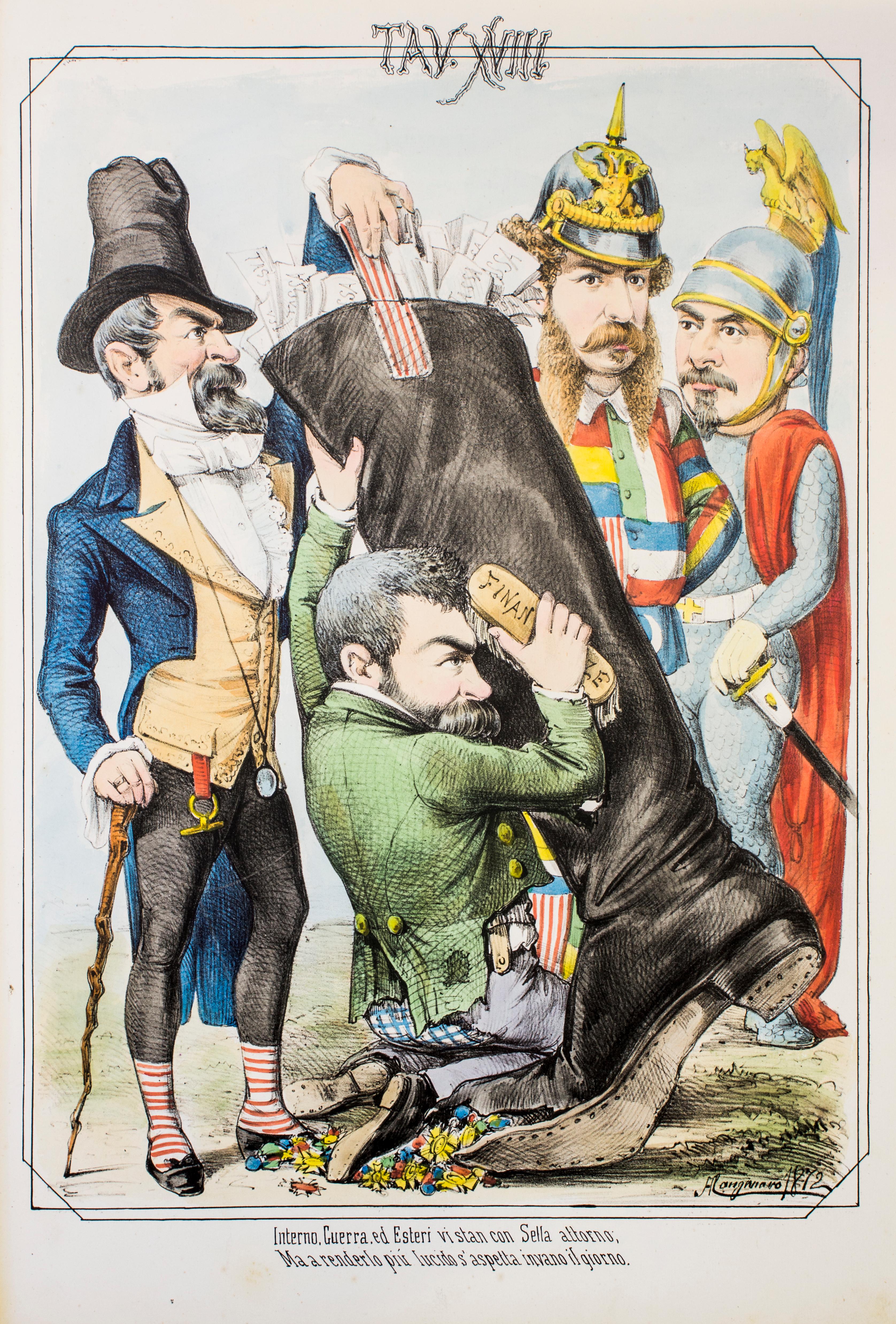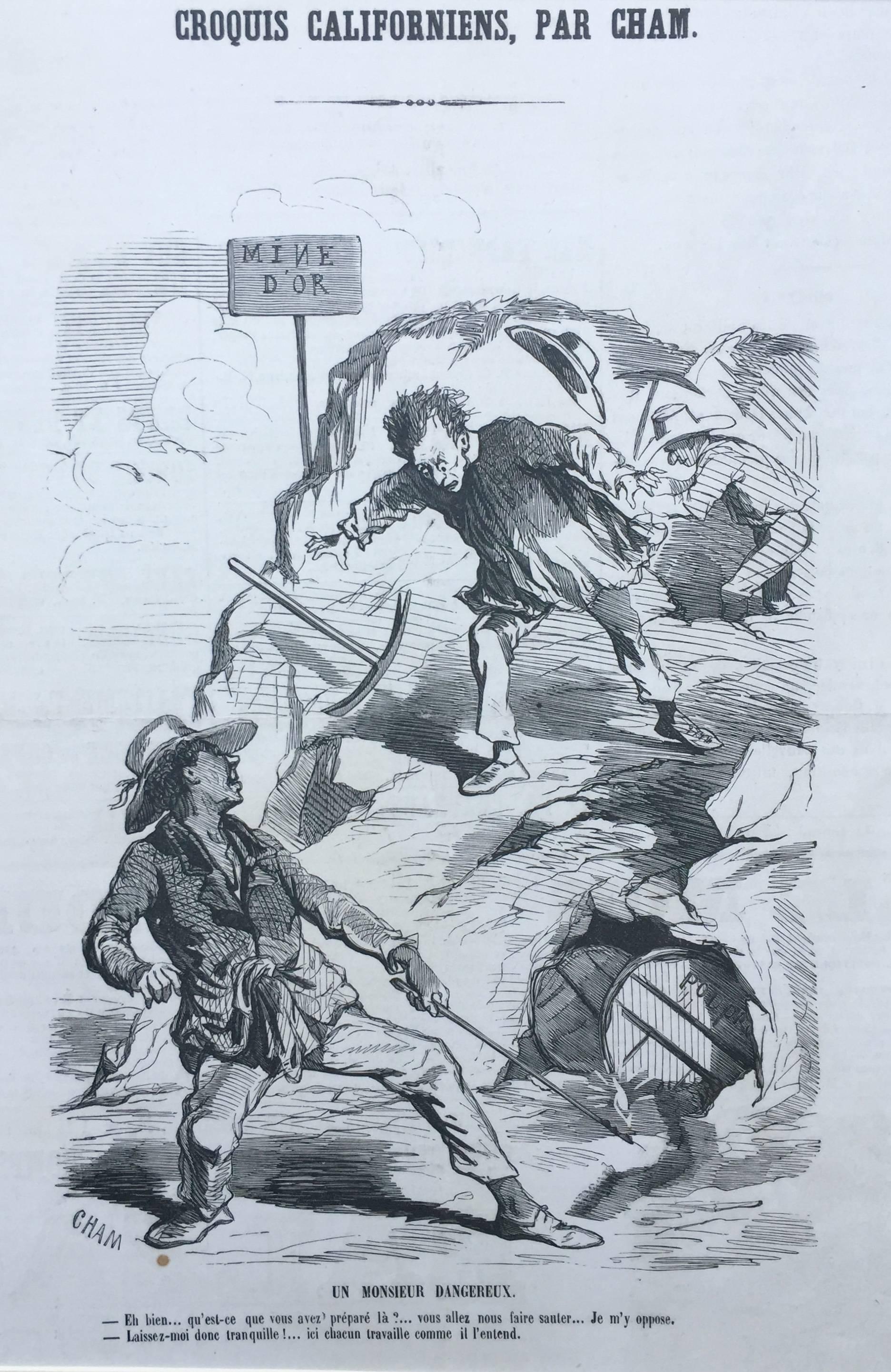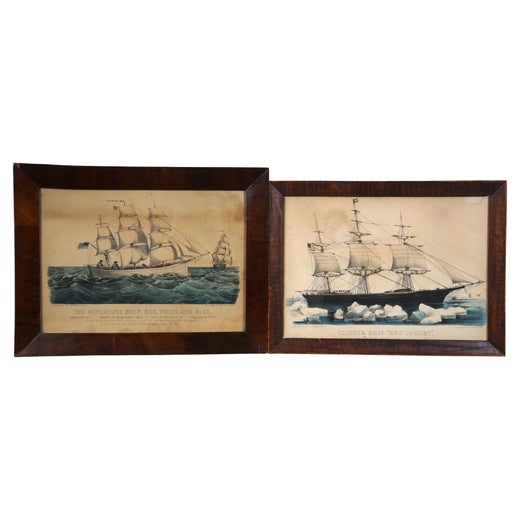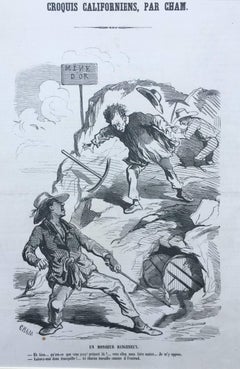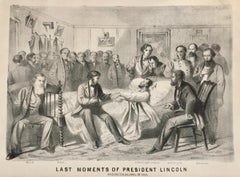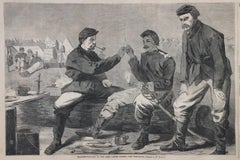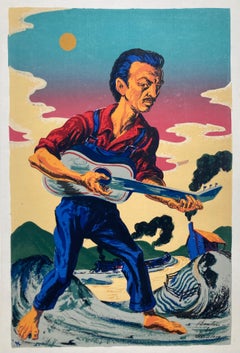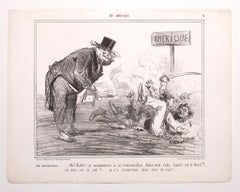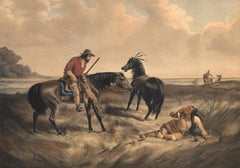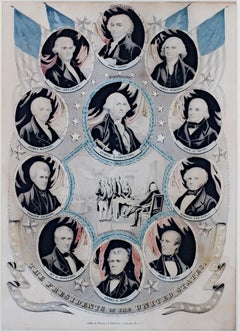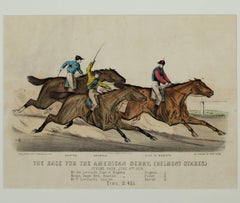Items Similar to CURRIER & IVES - 1860 LINCOLN ELECTION CAMPAIGN
Want more images or videos?
Request additional images or videos from the seller
1 of 12
Currier & IvesCURRIER & IVES - 1860 LINCOLN ELECTION CAMPAIGN1860
1860
$1,350
£1,025.55
€1,181.26
CA$1,931.31
A$2,118.14
CHF 1,092.41
MX$25,302.93
NOK 13,855.10
SEK 12,997.65
DKK 8,824.92
About the Item
CURRIER & IVES (LOUIS MAURER)
1860 LINCOLN ELECTION CAMPAIGN
THE IMPENDING CRISES - OR CAUGHT IN THE ACT, 1860 (C.3033, G.3270)
Lithograph, attributed to Louis Maurer. 10 ¼ X 14 ¾”
The Impending Crises was an influential Anti-Slavery pamphlet.
Refers to Seward’s loss to Abraham Lincoln in the Republican primary, blaming Horace Greeley and the NY Tribune. The figures from left to right are Courier and Enquirer Editor, James Webb: Horace Greeley, NY Tribune editor: NY Daily News Editor Henry J. Raymond and William J. Seward in the water. Linen backed with center fold split. Some overall tone and some minor soiling, but otherwise good condition. $1,350
Civil War, Confederacy, Abraham Lincoln, Americana, Caricature, Presidency, Political cartoon.
- Creator:Currier & Ives (1834 - 1907, American)
- Creation Year:1860
- Dimensions:Height: 10.25 in (26.04 cm)Width: 14.75 in (37.47 cm)
- Medium:
- Period:
- Condition:
- Gallery Location:Santa Monica, CA
- Reference Number:1stDibs: LU41135948772
Currier & Ives
Currier and Ives was a prominent American printmaking establishment headquartered in New York operating from 1835 to 1907. Nathaniel Currier (1813-1888) started his business on his own, but later merged with James Merritt Ives (1824-1895), becoming "Currier and Ives" in 1857. They produced and sold hand-colored lithographs which could be produced relatively quickly and cheaply. They called themselves "the Grand Central Depot for Cheap and Popular Prints". The company published around 7,500 lithographs in its 72 years in business.
About the Seller
5.0
Recognized Seller
These prestigious sellers are industry leaders and represent the highest echelon for item quality and design.
Gold Seller
Premium sellers maintaining a 4.3+ rating and 24-hour response times
Established in 1977
1stDibs seller since 2016
296 sales on 1stDibs
Typical response time: 1 hour
Associations
International Fine Print Dealers Association
- ShippingRetrieving quote...Shipping from: Santa Monica, CA
- Return Policy
Authenticity Guarantee
In the unlikely event there’s an issue with an item’s authenticity, contact us within 1 year for a full refund. DetailsMoney-Back Guarantee
If your item is not as described, is damaged in transit, or does not arrive, contact us within 7 days for a full refund. Details24-Hour Cancellation
You have a 24-hour grace period in which to reconsider your purchase, with no questions asked.Vetted Professional Sellers
Our world-class sellers must adhere to strict standards for service and quality, maintaining the integrity of our listings.Price-Match Guarantee
If you find that a seller listed the same item for a lower price elsewhere, we’ll match it.Trusted Global Delivery
Our best-in-class carrier network provides specialized shipping options worldwide, including custom delivery.More From This Seller
View AllCALIFORNIA 1850 GOLD RUSH CARICATURE
By Charles Amedee de Noe (CHAM)
Located in Santa Monica, CA
CALIFORNIA GOLD RUSH CARICATURE
Charles Amédée de Noé, aka CHAM (1819 -1879)
CROQUIS CALIFORNIENS, ca. 1850
Lithograph image inc. text 10 ½ x 6, sheet 14 x 9 1/2 inches. French...
Category
1840s Barbizon School Figurative Prints
Materials
Lithograph
LAST MOMENTS OF PRESIDENT LINCOLN
Located in Santa Monica, CA
J. F. BUFFORD PUBLISHER and PRINTER
LAST MOMENTS OF PRESIDENT LINCOLN, April 15, 1865
Lithograph, very good impression. The 2 lower publishing lines ...
Category
1860s American Realist Figurative Prints
Materials
Lithograph
THANKSGIVING IN CAMP
By Winslow Homer
Located in Santa Monica, CA
AFTER - WINSLOW HOMER (1836-1910)
THANKSGIVING IN THE ARMY - After Dinner: the Wishbone, 1864
Original wood engraving as published by Harpers Weekly December 3, 1864, after a drawing by Winslow Homer. Image 9 3/4" x 14, Sheet 10 3.\/4 x 15 3/4" . Generally good condition, a small stain in the upper right margin.
Homer contributed drawings to Harper's Weekly from 1857 to 1875. They were converted to wood engravings by Harper's craftsman and published in Harper's Weekly. Although after his original drawings, they are now accepted as an important part of his body of work by museums and collectors. They were very large editions. As such, they occur often in the marketplace. Harper's published during the Civil War years as this was, were widely read and kept as people followed the war first hand and its aftermath over the years continuing today as both Homer and Civil War collectables
Category
1860s American Realist Figurative Prints
Materials
Woodcut
$175 Sale Price
53% Off
THOMAS HART BENTON
By Harry Sternberg
Located in Santa Monica, CA
HARRY STERNBERG (American, 1904-2001)
THOMAS BENTON, 1943. Color screenprint on gray card stock wove paper. Edition of 30. Signed "Benton by Sternberg" in ink, by hand by the artist...
Category
1940s American Modern Figurative Prints
Materials
Screen
CALIFORNIA GOLD DIGGERS
Located in Santa Monica, CA
CALIFORNIA GOLD RUSH - c. 1849 - Early
CALIFORNIA GOLD DIGGERS - Mining Operations on the Western Shore of the Sacramento River, 1849 (Finley 111) Lithogr...
Category
1840s Other Art Style Prints and Multiples
Materials
Lithograph
WHAT DOES ART MEAN HERE? - WAS HEISST HIER KUNST?
By Andreas Paul Weber
Located in Santa Monica, CA
ANDREAS PAUL WEBER (German 1893-1980)
WAS HEISST HIER KUNST? (WHAT DOES ART MEAN HERE?) c 1953
Lithograph, signed in pencil and with the artist's Clan Press Stamp lower left corner. Image including the light PRINTED BORDER AROUND THE IMAGE is 15 1/2 x 18 3/4 inches. The full sheet 19 3/4 x 24 1/2 inches with deckle edges.. IN VERY GOOD CONDITION. SHEET FRESH AND EVEN - PHOTO IS TOO DARK!!
An image of EDVARD MUNCH''S "THE SCREAM" is below a satirical image of a man eating a sausage sitting on top of other works of art including - GOYA"S "SLEEP OF REASON...
Category
1950s Modern Figurative Prints
Materials
Lithograph
You May Also Like
America - Original Lithograph by CHAM - 19th century
By Charles Amedee de Noe (CHAM)
Located in Roma, IT
America is an original lithograph on paper realized by Charles Amédee de Noe, best known as Cham.
On the lower right corner, lith. Destouches, 28, r. Paradis.
On the lower-left cor...
Category
19th Century Modern Figurative Prints
Materials
Lithograph
The Last War-Whoop!
By Currier & Ives
Located in Palm Desert, CA
"The Last War-Whoop!" is a lithograph by Currier & Ives. The framed size is 26 x 32.62 x 1.25 inches.
Provenance:
Private Collection
Category
Late 19th Century American Realist Landscape Prints
Materials
Lithograph
19th century color lithograph portraits patriotic American stars flags
By Nathaniel Currier
Located in Milwaukee, WI
"The Presidents of the U.S." is an original hand-colored lithograph by Nathaniel Currier. It features the first eleven presidents of the United States.
14" x 10" art
23" x 19 1/8" frame
Nathaniel Currier was born March 27, 1813 to Nathaniel and Hannah Currier in Roxbury, Massachusetts. At the age of fifteen he was apprenticed to William S. and John Pendleton of Boston who had set up the first lithographic establishment in America. His apprenticeship served him well as he went on to be the largest publisher of lithographs. Mr. Maurer described Nat Currier as being very gentlemanly and liberal. As is evident to the success of the firm of Currier & Ives he was very devoted to his business.
Nat Currier had many friends including Horace Greely and P.T. Barnum. He was well known for his sense of humor and Harry T. Peters tells one story about P. T. Barnum. "Currier had heard that one day his friend, the great showman, had rushed into the barber shop of the old Park Hotel, at Beekman and Nassau Streets, to get a shave. Barnum had hurried up to Tom Higginson, the barber, and said, 'Tom, I'm in a hurry.' 'Sorry for it,' said Tom, 'but it's that gentleman's turn next.' 'That gentleman' was an unshaven irshman waiting for a ten-cent shave. Barnum turned to him and said, 'My friend, if you will let me have your turn, I'll pay for what you have done.' The gentleman consented, and, as Barnum found out later, had a full job done - absolutely everything the house had. The check was for a dollar and sixty cents. When Currier heard this story he found the very Irishman and had him pose. The result was the famous cartoon, "The Man that Gave Barnum 'His Turn.'"
Nathaniel was married twice; his first wife was Miss Eliza West of Boston. He had one son with Eliza, Edward West Currier. In 1847 he married Miss Laura Ormsbee of Vermont. Laura and Nathaniel are memorialized in the famous N. Currier lithograph The Road Winter...
Category
1840s Academic Portrait Prints
Materials
Lithograph
19th century color lithograph horses figures dynamic landscape
By Currier & Ives
Located in Milwaukee, WI
"The Race for the American Derby (Belmont Stakes)" is an original hand-colored lithograph published by Currier & Ives. It depicts three racehorses and their jockeys running in the Belmont Stakes. The caption for this lithograph says, "Spartan. Bramble. Duke of Magenta. Jerome Park, June 8th 1878. Mr. Geo. Lorillard's Duke of Magenta.....Hughes, 1....Messrs.Dwyer Bro's Bramble......Fisher, 2....Mr. P. Lorillard's Spartan.....Barrett, 3..... TIME 2:43 1/2."
12 7/8" x 16 7/8" art
21 7/8" x 25 7/8" frame
Currier & Ives produced their prints in a building at 33 Spruce Street where they occupied the third, fourth and fifth floors. The third floor was devoted to the hand operated printing presses that were built by Nat's cousin, Cyrus Currier, at his shop Cyrus Currier & Sons in Newark, NJ. The fourth floor found the artists, lithographers and the stone grinders...
Category
1870s Animal Prints
Materials
Lithograph
The Ministers - Original Lithograph by A. Maganaro - 1872
By Antonio Manganaro
Located in Roma, IT
I Ministri is an original artwork realized in 1872 by Antonio Manganaro.
Original colored lithograph.
Good conditions except for a light yellowing of paper due to the time and some...
Category
1870s Figurative Prints
Materials
Lithograph
19th century color lithograph seascape boat ship waves maritime landscape
By Currier & Ives
Located in Milwaukee, WI
"The Celebrated Clipper Ship Dreadnought" is an original hand-colored lithograph by Currier & Ives. It depicts a sailing ship.
13 1/4" x 17 1/2" art
19" x 23 1/2" frame
Nathaniel Currier was a tall introspective man with a melancholy nature. He could captivate people with his piercing stare or charm them with his sparkling blue eyes. Nathaniel was born in Roxbury, Massachusetts on March 27th, 1813, the second of four children. His parents, Nathaniel and Hannah Currier, were distant cousins who lived a humble yet spartan life. When Nathaniel was eight years old, tragedy struck. Nathaniel’s father unexpectedly passed away leaving Nathaniel and his eleven-year-old brother Lorenzo to provide for the family. In addition to their mother, Nathaniel and Lorenzo had to care for six-year-old sister Elizabeth and two-year-old brother Charles. Nathaniel worked a series of odd jobs to support the family, and at fifteen, he started what would become a life-long career when he apprenticed in the Boston lithography shop of William and John Pendleton.
A Bavarian gentleman named Alois Senefelder invented lithography just 30 years prior to young Nat Currier’s apprenticeship. While under the employ of the brothers Pendleton, Nat was taught the art of lithography by the firm’s chief printer, a French national named Dubois, who brought the lithography trade to America.
Lithography involves grinding a piece of limestone flat and smooth then drawing in mirror image on the stone with a special grease pencil. After the image is completed, the stone is etched with a solution of aqua fortis leaving the greased areas in slight relief. Water is then used to wet the stone and greased-ink is rolled onto the raised areas. Since grease and water do not mix, the greased-ink is repelled by the moisture on the stone and clings to the original grease pencil lines. The stone is then placed in a press and used as a printing block to impart black on white images to paper.
In 1833, now twenty-years old and an accomplished lithographer, Nat Currier left Boston and moved to Philadelphia to do contract work for M.E.D. Brown, a noted engraver and printer. With the promise of good money, Currier hired on to help Brown prepare lithographic stones of scientific images for the American Journal of Sciences and Arts. When Nat completed the contract work in 1834, he traveled to New York City to work once again for his mentor John Pendleton, who was now operating his own shop located at 137 Broadway. Soon after the reunion, Pendleton expressed an interest in returning to Boston and offered to sell his print shop to Currier. Young Nat did not have the financial resources to buy the shop, but being the resourceful type he found another local printer by the name of Stodart. Together they bought Pendleton’s business.
The firm ‘Currier & Stodart’ specialized in "job" printing. They produced many different types of printed items, most notably music manuscripts for local publishers. By 1835, Stodart was frustrated that the business was not making enough money and he ended the partnership, taking his investment with him. With little more than some lithographic stones, and a talent for his trade, twenty-two year old Nat Currier set up shop in a temporary office at 1 Wall Street in New York City. He named his new enterprise ‘N. Currier, Lithographer’
Nathaniel continued as a job printer and duplicated everything from music sheets to architectural plans. He experimented with portraits, disaster scenes and memorial prints, and any thing that he could sell to the public from tables in front of his shop. During 1835 he produced a disaster print Ruins of the Planter's Hotel, New Orleans, which fell at two O’clock on the Morning of the 15th of May 1835, burying 50 persons, 40 of whom Escaped with their Lives. The public had a thirst for newsworthy events, and newspapers of the day did not include pictures. By producing this print, Nat gave the public a new way to “see” the news. The print sold reasonably well, an important fact that was not lost on Currier.
Nat met and married Eliza Farnsworth in 1840. He also produced a print that same year titled Awful Conflagration of the Steamboat Lexington in Long Island Sound on Monday Evening, January 18, 1840, by which melancholy occurrence over One Hundred Persons Perished. This print sold out very quickly, and Currier was approached by an enterprising publication who contracted him to print a single sheet addition of their paper, the New York Sun. This single page paper is presumed to be the first illustrated newspaper ever published.
The success of the Lexington print launched his career nationally and put him in a position to finally lift his family up. In 1841, Nat and Eliza had their first child, a son they named Edward West Currier. That same year Nat hired his twenty-one year old brother Charles and taught him the lithography trade, he also hired his artistically inclined brother Lorenzo to travel out west and make sketches of the new frontier as material for future prints. Charles worked for the firm on and off over the years, and invented a new type of lithographic crayon which he patented and named the Crayola. Lorenzo continued selling sketches to Nat for the next few years.
In 1843, Nat and Eliza had a daughter, Eliza West Currier, but tragedy struck in early 1847 when their young daughter died from a prolonged illness. Nat and Eliza were grief stricken, and Eliza, driven by despair, gave up on life and passed away just four months after her daughter’s death.
The subject of Nat Currier’s artwork changed following the death of his wife and daughter, and he produced many memorial prints and sentimental prints during the late 1840s. The memorial prints generally depicted grief stricken families posed by gravestones (the stones were left blank so the purchasers could fill in the names of the dearly departed). The sentimental prints usually depicted idealized portraits of women and children, titled with popular Christian names of the day.
Late in 1847, Nat Currier married Lura Ormsbee, a friend of the family. Lura was a self-sufficient woman, and she immediately set out to help Nat raise six-year-old Edward and get their house in order. In 1849, Lura delivered a son, Walter Black Currier, but fate dealt them a blow when young Walter died one year later. While Nat and Lura were grieving the loss of their new son, word came from San Francisco that Nat’s brother Lorenzo had also passed away from a brief illness. Nat sank deeper into his natural quiet melancholy. Friends stopped by to console the couple, and Lura began to set an extra place at their table for these unexpected guests. She continued this tradition throughout their lives.
In 1852, Charles introduced a friend, James Merritt Ives, to Nat and suggested he hire him as a bookkeeper. Jim Ives was a native New Yorker born in 1824 and raised on the grounds of Bellevue Hospital where his father was employed as superintendent. Jim was a self-trained artist and professional bookkeeper. He was also a plump and jovial man, presenting the exact opposite image of his new boss.
Jim Ives met Charles Currier through Caroline Clark, the object of Jim’s affection. Caroline’s sister Elizabeth was married to Charles, and Caroline was a close friend of the Currier family. Jim eventually proposed marriage to Caroline and solicited an introduction to Nat Currier, through Charles, in hopes of securing a more stable income to support his future wife.
Ives quickly set out to improve and modernize his new employer’s bookkeeping methods. He reorganized the firm’s sizable inventory, and used his artistic skills to streamline the firm’s production methods. By 1857, Nathaniel had become so dependent on Jims’ skills and initiative that he offered him a full partnership in the firm and appointed him general manager. The two men chose the name ‘Currier & Ives’ for the new partnership, and became close friends.
Currier & Ives produced their prints in a building at 33 Spruce Street where they occupied the third, fourth and fifth floors. The third floor was devoted to the hand operated printing presses that were built by Nat's cousin, Cyrus Currier, at his shop Cyrus Currier & Sons in Newark, NJ. The fourth floor found the artists, lithographers and the stone grinders at work. The fifth floor housed the coloring department, and was one of the earliest production lines in the country. The colorists were generally immigrant girls, mostly German, who came to America with some formal artistic training. Each colorist was responsible for adding a single color to a print. As a colorist finished applying their color, the print was passed down the line to the next colorist to add their color. The colorists worked from a master print displayed above their table, which showed where the proper colors were to be placed. At the end of the table was a touch up artist who checked the prints for quality, touching-in areas that may have been missed as it passed down the line. During the Civil War, demand for prints became so great that coloring stencils were developed to speed up production.
Although most Currier & Ives prints were colored in house, some were sent out to contract artists. The rate Currier & Ives paid these artists for coloring work was one dollar per one hundred small folios (a penny a print) and one dollar per one dozen large folios. Currier & Ives also offered uncolored prints to dealers, with instructions (included on the price list) on how to 'prepare the prints for coloring.' In addition, schools could order uncolored prints from the firm’s catalogue to use in their painting classes.
Nathaniel Currier and James Merritt Ives attracted a wide circle of friends during their years in business. Some of their more famous acquaintances included Horace Greeley, Phineas T. Barnum, and the outspoken abolitionists Rev. Henry Ward, and John Greenleaf Whittier (the latter being a cousin of Mr. Currier).
Nat Currier and Jim Ives described their business as "Publishers of Cheap and Popular Pictures" and produced many categories of prints. These included Disaster Scenes, Sentimental Images, Sports, Humor, Hunting Scenes, Politics, Religion, City and Rural Scenes, Trains, Ships, Fire Fighters, Famous Race Horses, Historical Portraits, and just about any other topic that satisfied the general public's taste. In all, the firm produced in excess of 7500 different titles, totaling over one million prints produced from 1835 to 1907.
Nat Currier retired in 1880, and signed over his share of the firm to his son Edward. Nat died eight years later at his summer home 'Lion’s Gate' in Amesbury, Massachusetts. Jim Ives remained active in the firm until his death in 1895, when his share of the firm passed to his eldest son, Chauncey.
In 1902, faced will failing health from the ravages of Tuberculosis, Edward Currier sold his share of the firm to Chauncey Ives...
Category
1870s Other Art Style Prints and Multiples
Materials
Lithograph




